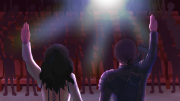The Green Hornet has suffered from the expectations it created. While the film is — as I write this — the highest grossing currently in theatres, 79 per cent of top critics have panned it. The Detroit News called it “a big, sloppy, loud, grating mess of a movie.” Those who were enticed by the possibilities of a Michel Gondry/Seth Rogen collaboration have lashed out at the film for failing to achieve the kind of originality a collaboration like this suggests. A.O. Scott summed up the feeling, calling the film “quite a bit less appealing than the sum of its parts.” Anyone who expected a straightforward superhero movie has surely been sorely disappointed.
The only element of The Green Hornet that lives up to expectations is Seth Rogen’s performance, and perhaps this is for the best. The aesthetics of Gondry, Rogen and the previous Green Hornet movies, television shows and comic books forced into a single film would have been a disaster. It was necessary that one of these influences dominate. As it happens, it is Rogen.
Rogen is completely at home as the layabout son of a millionaire newspaper man. Britt Reid is a typical Rogen character, but his circumstances are novel enough to keep him from going stale. Reid is just sensitive enough to make his incompetence and petulance funny instead of grating. Kato, played by Taiwanese pop music giant Jay Chou, is refreshingly neither cold and infallible nor exotic: he sings along to Coolio’s “Gangster’s Paradise,” lies about his success with women and drinks beer as readily as Reid.
The Green Hornet’s success relies entirely on the considerable charm of Rogen and Chou. The plot is undeniably formulaic — so much so that without constant distraction, it would have become insufferable. Thankfully, these distractions are provided in ample supply.
One of these distractions is the action. The Green Hornet doesn’t bring anything notably new to fight and chase scenes. The only stylistic anomalies in the action scenes are some comically accelerated movements and some occasional cuts to Kato’s point of view, in which weapons emit a bright red glow and everything is in slow motion. Neither of these is particularly compelling, but what Hornet’s action scenes lack in finesse they make up in guns.
The filmmakers cleverly recognized the Green Hornet’s car, the “Black Beauty,” as an opportunity to outfit their heroes with more guns than could ever be expected to adorn any single person. The Beauty is relatively unencumbered by nets, grappling hooks and other items commonly found on the cars of masked heroes. Instead, it has guns and armour. Both the filmmakers and the stars approach the car with boyish enthusiasm. The Globe and Mail called the action sequences “a mess of hackneyed car chases and flying glass and bullets,” but it’s unrealistic to expect a car chase to be anything other than hackneyed. It can still be enjoyable.
While it’s most evident in the car, this enthusiasm shows through the whole film. From Reid’s excitement at the prospect of crime fighting to the villain’s constant concern that his clothing is insufficiently menacing, The Green Hornet is full of adolescent emotions. In this way, it does have some Gondry in it. What he and Rogen share is a childlike approach to life. For Rogen, it is manifested in his adolescent stupor and clumsy manner. For Gondry, it is his whimsy and wonder. In The Green Hornet, it is Rogen’s aesthetic that dominates, but there is more Gondry in it than is immediately apparent.
The Green Hornet may not be a Gondry film or a super hero film, as some would have liked, but it is a good Rogen film, and we can approach it accordingly.



